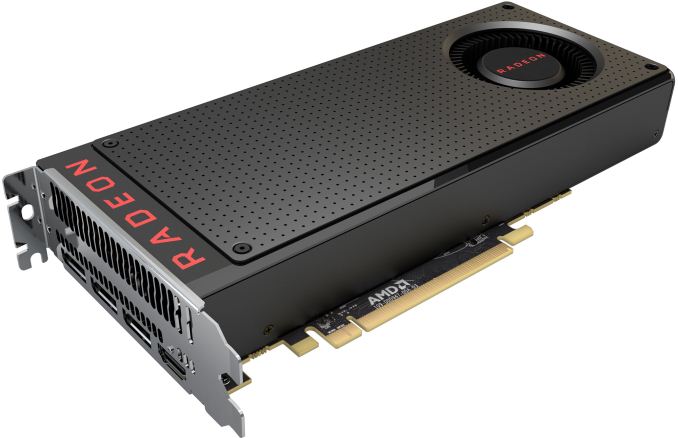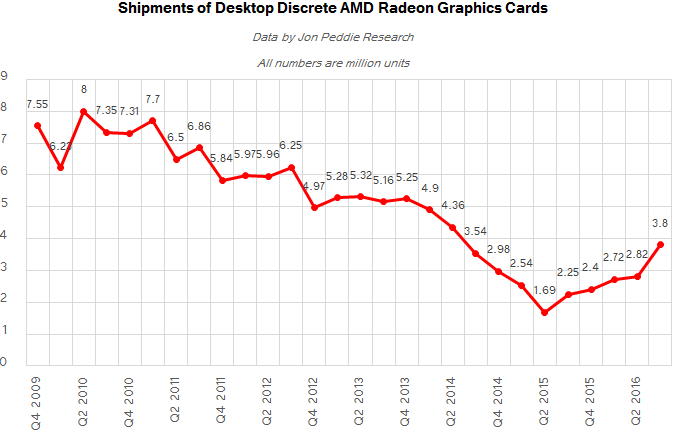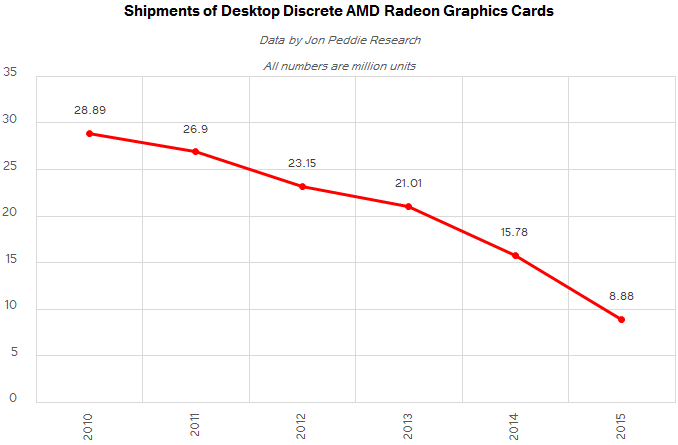Discrete Desktop GPU Market Trends Q3 2016: GPU Shipments Hit Two-Year High
by Anton Shilov on November 28, 2016 9:00 AM ESTAMD: Polaris Now Accounts for 50% of Channel GPU Revenue
Shipments of AMD’s GPUs (both standalone and integrated) were strong in Q3 2016: sales of desktop GPUs were up 34.7% QoQ, shipments of mobile GPUs were up 23% sequentially, supplies of desktop APUs decreased by 10% from the previous quarter and sales of mobile APUs grew by 19.1% QoQ, according to Jon Peddie Research. Overall, AMD’s PC graphics shipments increase by 15.4% from the previous quarter, JPR reports.
AMD does not disclose a lot of information about its GPU shipments. However, in its recent conference call the company confirmed that its quarterly channel GPU revenue and ASP in Q3 hit record levels since early 2014 and that the Radeon RX accounted for more than 50% of its channel GPU revenue. Furthermore, AMD said that its professional GPU revenue increased for the fourth consecutive quarter.
“The launch of our expanded family of Polaris desktop GPUs and our first full quarter of RX 480 sales drove our highest quarterly channel GPU revenue and ASP since early 2014,” said Lisa Su, CEO of AMD, during the conference call with investors and financial analysts. “The Radeon RX GPUs now account for more than 50% of our channel GPU revenue.”
AMD admitted that early in Q3 it could not meet demand for its new products made using 14 nm FinFET (14LPP) process technology, but things got better later in the quarter. As PC makers roll out new systems featuring AMD’s Polaris and other chips in Q4, the company hopes to either maintain or even increase its GPU shipments this quarter.
“We are very happy with how Polaris ramped in Q3,” said Dr. Su. “The customer demand across all geographies was very strong. Q3 was primarily a channel-based quarter. […] In the early part of Q3, we actually had some supply constraints, given the customer demand, [but] we did catch up towards the end of the quarter. […] As we go into Q4, in addition to the channel partners continuing to ramp, you should expect some OEMs launching in Q4 more broadly.”
AMD’s sales of desktop discrete GPUs in total for 2016 (Q1 to Q3) have already hit 9.34 million units, which is more than 8.8 million desktop graphics processors the company shipped in 2015. It is unknown whether AMD manages to increase its desktop GPU sales in Q4 substantially over Q3 to actually beat its 2014 results (15.78 million), but it is clear that AMD’s desktop GPU business is performing better this year than it did in 2015.
From the market share point of view, it remains to be seen how well AMD will respond to challenges imposed by NVIDIA’s Pascal GPUs in the performance market segment (i.e., $100-$249). In Q3 the company had to compete against NVIDIA’s Pascal-based GeForce GTX 1070/1080 graphics cards using its products released in 2015 (Fiji) and 2013 (Hawaii). None of those chips are manufactured or supplied today, which is why we see that prices of the Radeon R9 Fury- and the Radeon R9 390-series graphics cards vary greatly (e.g., you can get a Fury X for $299.99 after $30 rebate, or you can get the same card for $799.95). Some of AMD’s partners attempt to get rid of older products, others believe that since there will be no more Fiji or Hawaii chips, they will be able to capitalize on short supply of AMD’s high-end GPUs in the fourth quarter. In the meantime, AMD itself is gearing up to launch its Greenland/Vega high-end GPU in 2017 and has no plans to ship more Fiji or Hawaii processors (at least in mass quantities for consumer graphics adapters).













53 Comments
View All Comments
DwayneAK - Wednesday, November 30, 2016 - link
Also MSI, Gigabyte, and XFX are pretty good. And as far as AMD's 'lousy' partners go, I think Powercolor and Sapphire are pretty underrated.Michael Bay - Thursday, December 1, 2016 - link
After using their 980 for a year, I don`t think EVGA is especially good. My next purchase, if I`ll even bother, will be ASUS as usual.just4U - Friday, December 2, 2016 - link
I never had any more issues with Ati/Amd drivers then I had with Nvidia drivers... not ever.. I always believed it was just a rumor put out to try and keep Nvidia sales up and ati/amd down.vladx - Wednesday, December 7, 2016 - link
And now you know you were wrong and they were in fact very real. Heck, I had to sell my old laptop and buy a new one with Nvidia card and thus lose hundreds of euros because of how bad AMD drivers were.zmeul - Monday, November 28, 2016 - link
quick question: why are you using the term "GPU" interchangeably with video card?!in one paragraph you talk about video adapter, discrete graphics and in the next you say "various manufactures sold xyz GPUs"
the GPU is the chip inside the video card and has been the de facto definition since 1999:
"a single chip processor with integrated transform, lighting, triangle setup/clipping, and rendering engines that is capable of processing a minimum of 10 million polygons per second"
TheinsanegamerN - Monday, November 28, 2016 - link
Aside from you needing to be pedantic about grammar, the term "GPU" has been used to describe a video card for years. It's nothing new.heffeque - Monday, November 28, 2016 - link
Don't mind him. He's been living under a rock and can't catch up with normal tech language.zmeul - Monday, November 28, 2016 - link
the term GPU is already defined (since 1999) and it's not used to describe a video cardthe people who use it to describe a video card, do it wrongly
BrokenCrayons - Monday, November 28, 2016 - link
Is it worth mentioning that you didn't even attempt to use correct punctuation or capitalization while nitpicking about the usage of technical jargon? :)Anyway, the fact that you understood what the author meant when using the term "GPU" to refer to a video card means that the intended message reached the recipient, was decoded correctly, and information was shared. The goal of effective communication was achieved.
Besides that, English hasn't quite caught up with computer industry jargon. Credible dictionary publishers don't really include GPU in their work and there aren't defined, formal rules regarding its usage. In fact, you could argue that the term "GPU" was just something Nvidia made popular during the introduction of the first GeForce graphics cards. It became a commonly used term in the industry, but it was originally just marketing jargon that helped the company differentiate their video processors that included hardware transform and lighting from other competing products. Getting wrapped up in the terminology just seems sort of silly given its origin. There's also the idea of linguistic drift either which is something else you're ignoring because it doesn't support your barely relevant criticism.
Meteor2 - Wednesday, November 30, 2016 - link
This was confusing me too. In an article discussing shipments of AIBs and GPUs, it's best to be precise, because they *are* different things.It would be like calling a complete computer a CPU.